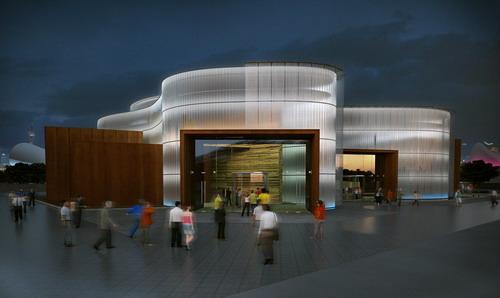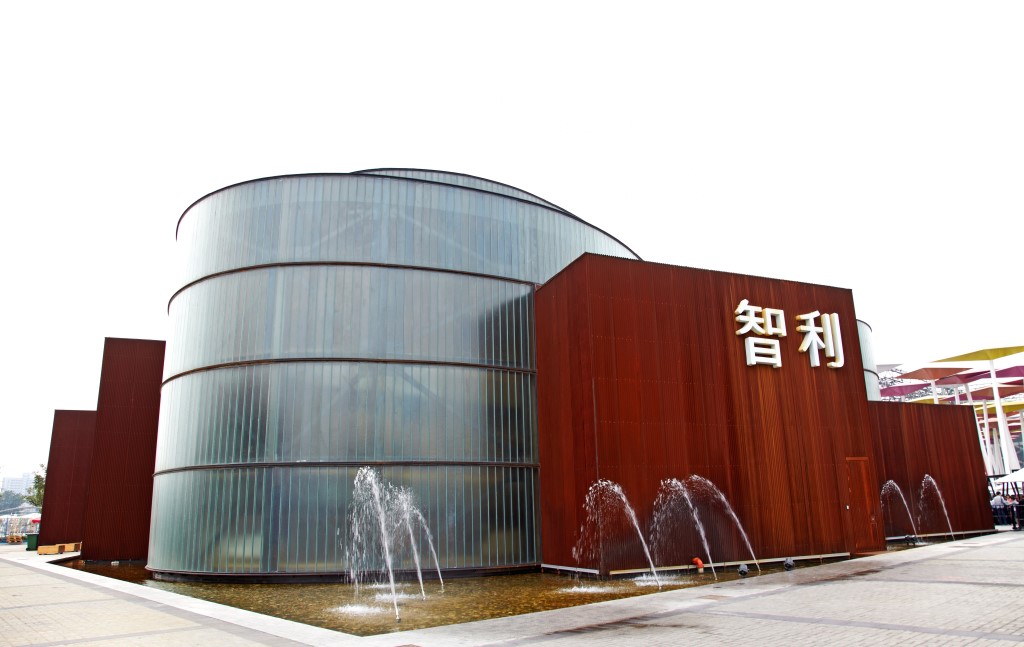The application of U-profile glass in the Chile Pavilion at the Shanghai World Expo was not merely a material choice, but a core design language that closely aligned with the pavilion’s theme of “City of Connections,” its environmental philosophy, and functional needs. This application concept can be broken down into four dimensions—theme resonance, sustainable practice, functional integration, and aesthetic expression—achieving a high degree of unity between the material’s characteristics and the pavilion’s core values.
I. Core Concept: Echoing the “City of Connections” Theme with “Translucent Links”
The core theme of the Chile Pavilion was “City of Connections,” which aimed to explore the essence of “connection” in cities—the symbiosis between people, between humans and nature, and between culture and technology. The translucent (light-permeable but non-transparent) property of U-profile glass served as a tangible embodiment of this theme:
“Sense of connection” through light and shadow: Though U-profile glass functioned as an enclosure structure, it allowed natural light to penetrate the building’s exterior, creating a flowing blend of light and shadow inside and outside. During the day, sunlight passed through the glass, casting soft, dynamic light patterns on the exhibition hall’s floors and walls—simulating the light changes across Chile’s long and narrow territory (encompassing glaciers and plateaus) and symbolizing the “connection between nature and the city.” At night, indoor lights diffused outward through the glass, turning the pavilion into a “transparent luminous body” in the World Expo campus, which stood for the “emotional link that breaks down barriers and allows people to ‘see’ one another.”
“Sense of lightness” in vision: Traditional walls tend to create a sense of enclosure in space, while the translucency of U-profile glass weakened the building’s “sense of boundary.” Visually, the pavilion resembled an “open container,” echoing the spirit of “openness and connection” advocated by the “City of Connections” theme, rather than a closed exhibition space.
II. Environmental Philosophy: Practicing “Recyclable and Low-Energy” Sustainable Design
The Chile Pavilion was one of the models of “sustainable architecture” at the Shanghai World Expo, and the application of U-profile glass was a key implementation of its environmental philosophy, mainly reflected in two aspects:
Material recyclability:The U-profile glass used in the pavilion contained 65%-70% recycled waste glass content, significantly reducing energy consumption and carbon emissions during the production of virgin glass. Meanwhile, U-profile glass adopted a modular installation method, which fully matched the pavilion’s design principle of “full disassembly and recycling except for the foundation.” After the World Expo, this glass could be completely disassembled, reprocessed, or reused in other construction projects—avoiding material waste after the demolition of traditional pavilions and truly realizing the “building lifecycle cycle.”
Adaptation to low-energy functions:The “light permeability” of U-profile glass directly replaced the need for artificial lighting in the exhibition hall during the day, reducing electricity consumption. Additionally, its hollow structure (the U-profile cross-section forms a natural air layer) had a certain thermal insulation performance, which could reduce the load on the pavilion’s air-conditioning system and indirectly achieve “energy conservation and carbon reduction.” This was consistent with Chile’s image as a “country with strong ecological protection awareness” and also responded to the overall advocacy of “low-carbon World Expo” at the Shanghai World Expo.
III. Functional Concept: Balancing “Lighting Needs” and “Privacy Protection”
As a public exhibition space, the pavilion needed to simultaneously meet the conflicting demands of “allowing visitors to clearly view exhibits” and “preventing excessive peeking at indoor exhibits from the outside.” The characteristics of U-profile glass perfectly addressed this pain point:
Light permeability ensuring exhibition experience: The high light transmittance of U-profile glass (far higher than that of ordinary frosted glass) allowed natural light to enter the exhibition hall evenly, avoiding glare-induced reflection on exhibits or visual fatigue for visitors. This was particularly suitable for the display needs of the pavilion’s “dynamic multimedia installations” (such as the “Chile Wall” interactive screen and the images in the giant dome space), making digital content more clearly presented.
Non-transparency protecting spatial privacy: The surface texture and cross-sectional structure of U-profile glass (which changes the refraction path of light) endowed it with the effect of “light-permeable but non-transparent.” From the outside, only the outline of light and shadow inside the pavilion could be seen, and no clear details of the interior could be observed. This not only protected the exhibition logic inside the hall from external interference but also allowed visitors to have a more focused viewing experience indoors, avoiding the discomfort of “being watched from the outside.”
IV. Aesthetic Concept: Conveying Chile’s Geographical and Cultural Characteristics through “Material Language”
The shape and installation method of U-profile glass also implicitly contained metaphors for Chile’s national cultural and geographical characteristics:
Echoing Chile’s “long and narrow geography”: Chile’s territory stretches in a long and narrow shape from north to south (spanning 38 latitudes). U-profile glass was designed in a “long strip modular arrangement” and laid continuously along the pavilion’s wavy exterior. Visually, this simulated the “stretching coastline and mountain ranges” of Chile’s geographical outline, turning the material itself into a “carrier of national symbols.”
Creating a “light and fluid” architectural temperament: Compared with stone and concrete, U-profile glass is lightweight. When combined with the pavilion’s steel structure frame, the entire building broke away from the “heaviness” of traditional pavilions and presented a transparent and agile appearance like a “crystal cup.” This not only matched Chile’s pure natural image of “abundant glaciers, plateaus, and oceans” but also enabled the pavilion to form a unique visual memory point among the numerous pavilions at the Shanghai World Expo.
Conclusion: U-profile Glass as the “Core Medium for Materializing Concepts”
The application of U-profile glass in the Chile Pavilion was not a mere accumulation of materials, but rather a transformation of the material into a “tool for theme expression, a carrier of environmental philosophy, and a solution to functional needs.” From the spiritual symbol of “connection” to the practical action of “sustainability,” and then to the functional adaptation of “experience optimization,” U-profile glass ultimately became the “core thread” that connected all the pavilion’s design goals. It also allowed the “humanistic and ecological” image of the Chile Pavilion to be perceived by visitors through concrete material language.
Post time: Sep-26-2025
